The day
begins
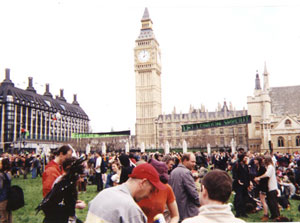
On May 1st.2000, traditionally
a public holiday throughout Western Europe, there were at
least three demonstrations in the centre of London.
Two of them, the Reclaim the
Streets demonstration, and the Workers Day gathering in
Trafalgar Square, were related in their antipathy towards
capitalism and corporate pillage of the Earth's
resources.
The third demonstration, as
reported in the established news media, was an illusion; an
exercise in news management and the political manipulation
of public opinion.
THE CENOTAPH
EFFECT
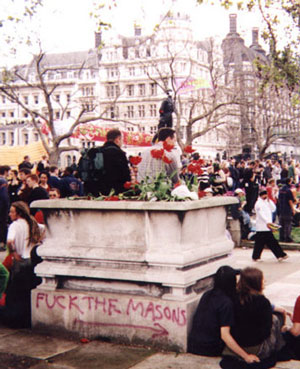
The tabloids claimed that the
Reclaim the Streets demonstration as a wholescale riot,
focussing their attention on a few wanton acts of decidedly
non-political graffiti. They seemed particularly outraged by
the addition of a removable green turf mohican on Winston
Churchill (despite his Native American ancestry), but it was
the graffiti on the Cenotaph which really seemed to drive
them to apoplexy.
In the true style of Neil
Kinnock, who shamefully dismissed the poll-tax protesters as
"enemies of freedom"; we were treated to a diatribe from
Tony Blair about the "idiots" not respecting the "freedom"
to demonstrate which was paid for by the lives of those
commemorated at the Cenotaph.
A number of points spring to
mind here, not the least being that a so-called Labour
leader seems to forget that it was the Chartists and other
subversives who paid with their lives, on the flagstones of
Peterloo and many other places much nearer to home than
Flanders, for the right to demonstrate.
It is worth remembering as well
that the First World War was an imperial war with no great
political difference between the major powers. Upper-class
statesmen, generals and bureaucrats narrowly averted the
threat of revolution, except in Russia, by sending the
working class of Europe to die in a futile
slaughter.
The Second World War was
reluctantly entered into by the upper class of this country,
as they had more than a sneaking regard for the Austrian
Corporal and the way he kept the lumpenprole in line, and
dealt with the Bolsheviks.
Both Mussolini's invasion of
Ethiopia, and the Spanish Civil War had been opportunities
for the British Establishment to confront the evils of
fascism before it dragged the world back into War. Despite
the fact that ordinary people could see the dangers well
enough by the time of the latter to join the International
Brigade and sacrifice their lives, the Establishment, (with
the exception of Churchill), did not seem so concerned.
Finally, a rhetorical point;
surely those millions of 'ordinary' heroes who fought and
fell in the two wars were promised a little more than a
block of stone and the right to demonstrate. Surely 'homes
for heroes', and the right not to have their children
fertilising some far-away field for the sake of someone's
political career. The right to a decent health service and a
pension to allow the old heroes to retire in dignity once
the battle was over.
These are obviously points
which have escaped Blair; but this is hardly surprising
considering his readiness to use the machinery of war to
enforce political objectives in Yugoslavia.
It will be interesting to see
just how the "Cenotaph Incident" will be used to curtail the
rights of people to demonstrate their alienation from the
system that he seems so keen to support.
An interesting footnote to this
particular incident was reported within two days of the
demonstration (The Guardian, 3rd May 2000 pg3).
English Heritage had offered to
board up the Cenotaph and other major statues in Whitehall
and Parliament Square. They were dissuaded by the
Metropolitan police, who assured them that all the monuments
would be protected for the duration of the
demonstration.
And just to throw in one more
drop of cynicism about the "spin", below is an extract from
The Guardian of May 6th, referring to the "Cenotaph effect"
on the London electorate in their poll for the first city
Mayor. It just goes to show that the sacrifice goes on even
when you're dead:
After a weekend of
anticapitalism protests culminating in the defacing of
the Cenotaph, significant numbers of Liberal Democrat and
Conservative voters appear to have changed their minds
about voting for Mr Livingstone. It appears that this
whiff of danger was enough to convince them to either sit
on their hands home or vote for Mr Norris in an attempt
to stop Mr Livingstone.
The figures are dramatic.
In the Standard/ICM poll a week before the election 47%
of Liberal Democrats said they were going to back Mr
Livingstone but in the end this figure slumped to 33%. He
won 24% of the Conservative vote, down from 29% the week
before.
There is also a sharp
divide in social class. Before the election, 57% of the
professional middle classes - the ABC1 voters - said they
were going to vote for Mr Livingstone but in the end,
this dropped to 37%. It was only among the DE manual
workers that his support, at around 43%, held
up.
THE
DEMONSTRATION
I arrived in Parliament Square
about 13.00 hrs. Wandering down Whitehall from the Strand, I
was surprised by the mellow atmosphere. There was a thin
trail of people going the same way; less hardcore activists,
more social worker hippies; more than a few with their
children.
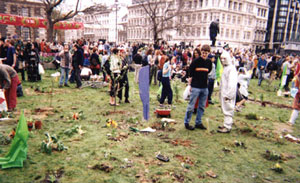
In the Square itself, banners
had been strung across from trees, and there were probably
about 1-2000 people milling about. Many were engaged in
"guerrilla gardening" activities. A few people were busy
creating an allotment in the middle of the turf square;
others were processing around the edges of the square
dressed in various carnival type costumes.
One group of people had put up
what was probably the first Maypole in Parliament Square
since before Cromwell.
A couple of people were busy
trying to create a map of Britain out of turf on the road
opposite Parliament, which seemed to sum up the peacefully
symbolic intent of the demonstration. Most people were just
chilling out with a spliff and a drink in the hot sun;
catching up with old friends.
The atmosphere was already
strange, though.
Three sides of the square were
already surrounded by phalanxes of armoured police; and it
seemed as though everyone was being over-fluffy in a rather
strained way.
There were obviously men with
long-lens cameras in many of the windows with a view right
across the square, and armoured police cameramen began to
appear behind the front lines of riot police, blatantly
filming the demonstrators.
After a while I started to make
my way up to Trafalgar Square with a few friends. A crowd of
people had already started to wander up that way, with the
intention of joining the end of the Workers Day
demonstration, which had taken place earlier.
As we started to go up
Whitehall, I noticed that the police in the side roads, who
had been sitting around in their shirtsleeves looking bored
when I passed earlier, were strapping on their helmets and
grabbing their shields. As we got past the General Slim
statue, we saw a few lines of them coming out into the road.
MACDONALDS
TRASHED
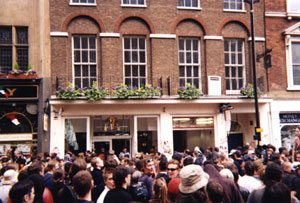
Even now when we joined up with
the main body of demonstrators, the mood of the crowd could
be described as subdued. Within less than five minutes
though, the Macdonald's had become the focus of everyone's
attention. Why it was open in the first place was perhaps
the cause of greatest surprise to everyone; it would not
have cost a big slice of daily profit to the Big Mac
Corporation to close that tiny branch for one day and pull
down the shutters. It would have been good manners, because
some people do really regard them as offensive.
It was not a great shock then,
when the windows went in and the place was comprehensively
trashed within minutes. The cheers of the crowd were
short-lived though, because almost instantaneously the
Parliament end of Whitehall was filled with police. Ranks of
riot police, police in vans, and within minutes police on
horseback. The crowd at this point disintegrated into
anarchy, the windows of the money exchange were smashed, and
a few ''''Welcome to London" tourist T-shirts thrown into
the fleeing crowd.
Within minutes the police were
in our midst, truncheons flailing, grabbing anyone who was
too slow or resisted. They began to drive the crowd into
Trafalgar Square partly through sheer weight of numbers, and
their obvious willingness to use violence on a mainly
peaceful and unresisting crowd.
DEMONSTRATORS TRAPPED
IN TRAFALGAR SQUARE
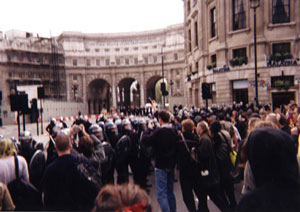
Once in Trafalgar Square, we
realised that the main aim of the police seemed to have been
to split up the Reclaim the Streets demonstrators into two
parts. Some people did try and face it out with police, who
had by now moved such a mass of troops into Whitehall, that
it was impossible to rejoin the two halves. Many people had
left friends or family back in Parliament Square.
Within an hour, the police had
totally cut the square off from the rest of London. Some
people in the Square were what they would describe as
activists; most were just there to show support for the aims
of the demonstration. Quite a few people were left from the
Workers Day meeting, including Kurdish communists and a
couple of SWP paper sellers.
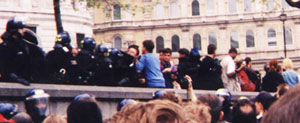
Almost imperceptibly the police
cut off all the exits out of the square. There were no more
tourists visible observing from the steps of St. Martins,
and they drove the Kurdish parties off the pavement in front
of the National Gallery, and down the steps into the square.
Their banners were ripped down, and the police seemed
determined to enforce a strategy of complete detainment.
Some of the Kurds did not seem very happy being pushed into
a square surrounded by armoured police. The police now
started to drive the press away from the square, to shouts
of "free press" from the crowd.
People had started to become
quite uneasy by this point, and even parts of the crowd who
had been attempting to break out of the cordon before, had
reached a point of uneasy stand-off with the front lines of
the police.
Behind every ten or so officers
was the cameraman, also in armour, filming everyone; on the
buildings surrounding the Square, were dozens of other
figures filming and photographing the people in the
Square.
After about three hours of
this; in which the police cordon became tighter and tighter,
allowing them in to film as close as they wanted, they began
to release the crowd - of about three thousand people- one
by one down the Haymarket.

As we were released through the
cordon, we were filmed again; just in case they had missed
anyone. Quite a few people, many of whom who had been filmed
protesting against their illegal detention in the Square for
four hours, were bundled off to cells to await the 'justice'
of the courts and the tabloids over the next
week.
All of us there are now fully
documented enemies of the realm, and every file must be
stuffed with illustrations.
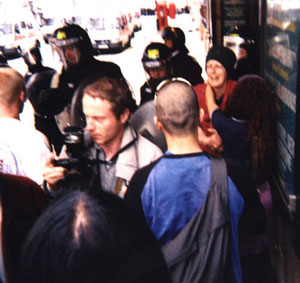
One wonders how much energy and
money is being thrown into the great war against guerrilla
gardening.
It is perhaps not surprising
that once the interior security service took over the job in
fighting terrorism from the Met (specifically Special
Branch); and once the war in Ireland was effectively over;
that they would turn their attention to citizens who they
regard as subversive.
The rest of us were left to
contemplate exactly what "freedoms' had been granted to us
by our masters in return for our forefathers' sacrifice over
the last few hundred years.
|